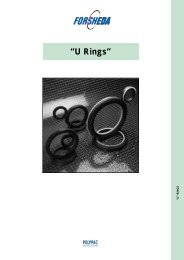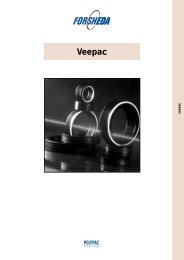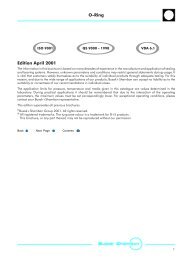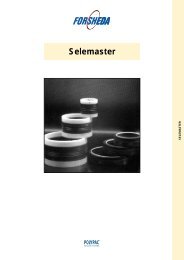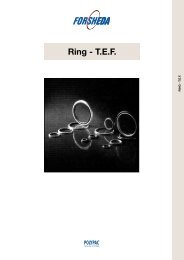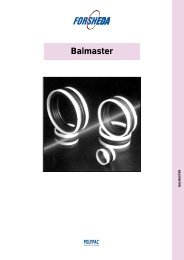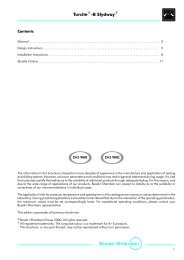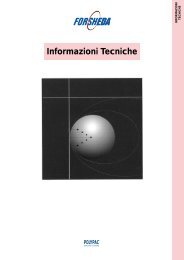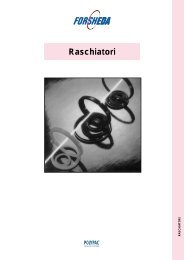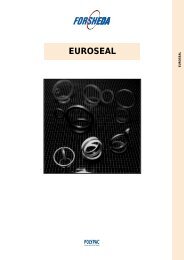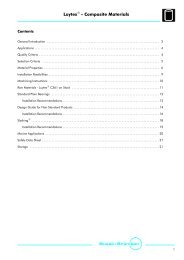Rotary Seals - Dilanda.it
Rotary Seals - Dilanda.it
Rotary Seals - Dilanda.it
You also want an ePaper? Increase the reach of your titles
YUMPU automatically turns print PDFs into web optimized ePapers that Google loves.
<strong>Rotary</strong> Seal<br />
n Introduction<br />
Rotating or pivoting devices require a lubrication fluid to<br />
secure the service life. To keep the lubrication fluid w<strong>it</strong>hin<br />
the system and avoid environmental pollution, <strong>Rotary</strong> shaft<br />
seals are usually installed. In most applications the seal is<br />
e<strong>it</strong>her partially or temporarily immersed or is simply<br />
exposed to splashing lubricant, particularly in engines,<br />
transmissions, gearboxes or axles. In the above applications<br />
the elastomeric shaft seals are required to provide leakfree<br />
sealing even at surface speeds up to 30 m/s and<br />
temperatures up to 200°C. At the same time the seal must<br />
prevent ingress of mud and water from outside. These<br />
high-speed applications operate generally w<strong>it</strong>hout or at<br />
very low pressure. When the speed is increasing (up to<br />
90 m/s) the sealing lip will be produced out of PTFE based<br />
materials (Turcon ® and other) to reduce the tangential<br />
friction force and consequently the heat generation.<br />
To solve various applications w<strong>it</strong>h working cond<strong>it</strong>ions<br />
characterised by low or medium circumferential speed<br />
and high pressures up to 20 MPa, B+S offers a wide range<br />
of profiles mainly produced out of PTFE based materials<br />
(Turcon ® and other). Very often fluids w<strong>it</strong>h good<br />
lubricating properties must be sealed at high pressures,<br />
but obviously non-lubricating fluids such as water,<br />
foodstuff, or chemicals need to be sealed. The large B+S<br />
material and product range will provide an adapted<br />
solution to your sealing problem provided that all<br />
working parameters have been carefully considered. A<br />
short description of the most cr<strong>it</strong>ical parameters can be<br />
found in the next chapter.<br />
n Working parameters<br />
Media<br />
The media to be sealed influences heavily the choice of the<br />
seal and material type. Mainly liquid media need to be<br />
sealed in rotary applications. Pasty media generally restrict<br />
the use of number of rotary seals available especially in<br />
terms of circumferential veloc<strong>it</strong>y. Gaseous media require<br />
specially adapted seal designs.<br />
Liquid media:<br />
Most of the applications relate to lubricating fluids but also<br />
hydraulic fluids based on mineral oils acc. DIN 51524 or<br />
ISO 6743 or fire resistant hydraulic fluids as well as<br />
environmentally friendly hydraulic fluids. In specific<br />
application aggressive media w<strong>it</strong>h low lubricating<br />
capabil<strong>it</strong>ies must be sealed. Sealing of other fluids such as<br />
water or FDA compliant fluids require in many cases a<br />
special sealing solution and will not be handled in details in<br />
this catalogue. For specific needs please contact your local<br />
B+S company. The media is the first cr<strong>it</strong>eria to be<br />
considered for the selection of the material type. It will<br />
influence as well the seal family as the profile.<br />
The evaluation of the compatibil<strong>it</strong>y of the seal material<br />
w<strong>it</strong>h the media to be sealed is based on the analysis of the<br />
values of tensile strength, elongation, volume change and<br />
hardness change resulting from an immersion test of<br />
testing slabs. A lot of compatibil<strong>it</strong>y tests have been<br />
carried out over years nevertheless for some media the<br />
results are not available. Please contact your local B+S<br />
company for further details.<br />
Mineral oils:<br />
Mainly in use in transmissions, they have on average,<br />
proven good compatibil<strong>it</strong>y w<strong>it</strong>h the elastomer materials<br />
w<strong>it</strong>hin the recommended temperature range. Some<br />
mineral oils e.g. hypoid transmission oils contain special<br />
add<strong>it</strong>ives allowing higher demand e.g. temperature range<br />
and/or high pressure which require a compatibil<strong>it</strong>y check in<br />
a field test.<br />
Synthetic oils:<br />
For improvement of the viscos<strong>it</strong>y, high temperature and/or<br />
service life, new oils w<strong>it</strong>h specific add<strong>it</strong>ives have been<br />
launched as partial or full synthetic oils. Basically the<br />
synthetic oils show the same good compatibil<strong>it</strong>y w<strong>it</strong>h the<br />
elastomer materials as the mineral oils. Also for these oil<br />
types the compatibil<strong>it</strong>y needs to be checked in case special<br />
ingredients are added to improve the viscos<strong>it</strong>y,<br />
temperature and pressure performance.<br />
Grease:<br />
Often used for roller and plain bearings, this media<br />
requires special adaptation of the sealing solution. To<br />
reduce the risk of tilting the sealing lip and allow the<br />
sealing lip to open under increasing pressure, the seal is<br />
installed in the reverse direction. Another important<br />
parameter to be considered is the maximum<br />
circumferential veloc<strong>it</strong>y. The maximum speed must be<br />
reduced to 50% of the perm<strong>it</strong>ted speed in oil, due to the<br />
poor heat exchange the grease can provide.<br />
Above this lim<strong>it</strong> the change from grease to oil or<br />
installation of seal w<strong>it</strong>h PTFE based lip (Turcon ® and<br />
other) should be considered.<br />
Poor lubricating media:<br />
For those media an in<strong>it</strong>ial lubrication of the seal is required<br />
to avoid dry running. In such applications we recommend<br />
the radial oil seal w<strong>it</strong>h dust lip. The area between the lips<br />
will be used as a lubricant reservoir. Two seals in tandem<br />
Radial oil seal/ Radial oils seal or Radial oil seal/GAMMA<br />
seal will provide the same result<br />
Latest information available at www.busakshamban.com<br />
Ed<strong>it</strong>ion April 2006<br />
9



